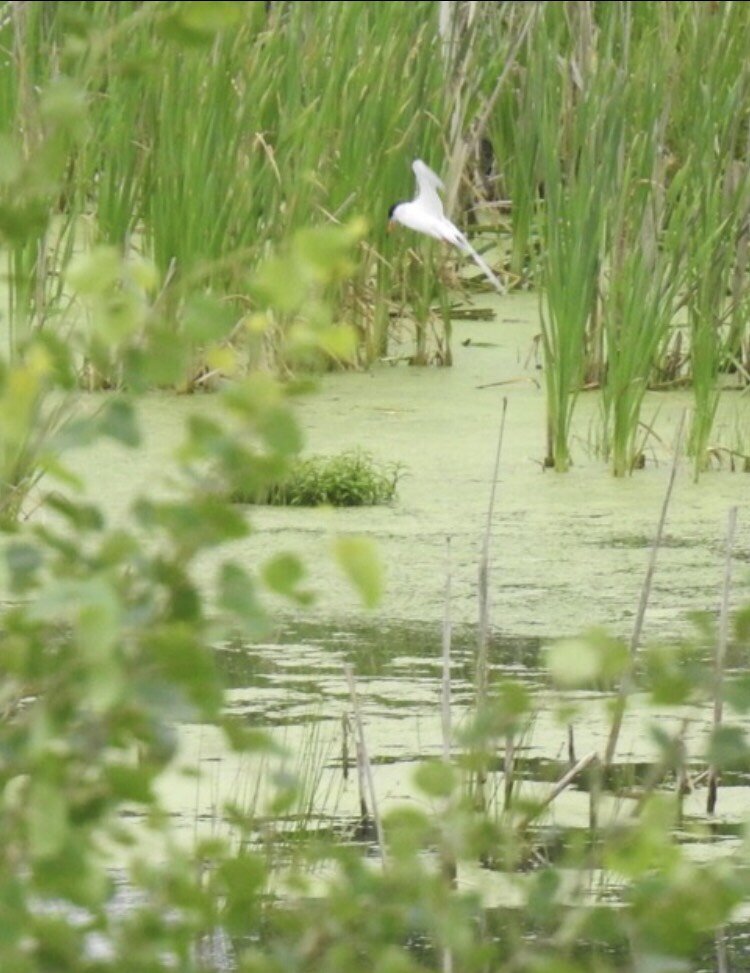This summer, a great blue heron spent what seemed like its every waking (and sleeping) moment on a wood duck box on the Hwy 89 pond. Every walk around the pond yielded a surprise when a tall figure against the backdrop of prairie, pothole, and aspen turned out to be the heron, again perched on the wood duck box.
There was one instance where this heron departed from its usual routine, as far as we saw it. While the interns and I were on North Shore Road, we witnessed the heron land in the pond. We observed the bird with binoculars for a minute, before it quickly stabbed a bullhead out of the water, gulped it down after a couple of tries, and then returned—where else—to the wood duck box.
In his regular perch. Photo by Drew Harry
I was surprised by the size of the fish in the pond. Yet years past have seen egrets, pelicans, and great blue herons raiding this resource.
I was also surprised, on July 19, when I witnessed a Forster’s tern flying over the 89 pond. This is an endangered bird in Wisconsin that nests in colonies, so my sighting was unlikely to be breeding individual of the immediate area. However, my sighting occurred right around the time when young are fledging, and after this period, parents often disperse more widely to forage for minnows in lakes, rivers, and ponds.
Foster’s tern at Hwy 89 pond. Photo by Drew Harry
In the area of Faville Grove, one nearby location stands out as a potential breeding location for Forster’s terns. The Chub and Mud Lake Riverine Marsh to the north, in Dodge County, covers nearly 7,000 acres of wetland habitat and harbors the appropriate riverine marsh habitat often preferred by Forster’s terns. Portions of this area were never platted during the Public Land Survey, because they were presumed to be a lake. For Wisconsin’s second Breeding Bird Atlas, a number of probable breeding pairs were found in this area.
Faville Grove likely holds wetlands too small and isolated to host breeding Forster’s terns. These birds look for extensive wetland marshes, often nesting on well-concealed islands of vegetation to avoid mammalian predators. Raccoons, skunks, opossums, and weasels, could all decimate the eggs of a colony of Forester’s terns, so nest site selection is key for these birds.
For this reason, only a few colonies in Wisconsin traditionally produce offspring. These areas include Big Muskego Lake, the upriver lakes of the Winnebago Pool, Rush Lake, and the western shore of Green Bay.
It’s interesting to note that many wetlands in the immediate vicinity of Faville Grove contain islands of potential habitat for Forster’s terns. Due perhaps to the unique chemical makeup of these low-lying areas, most boggy lowlands are surrounded by a “moat” of open water, which typically rings the entirety of the wetland.
Wetland “moat” at Faville marsh. Narrow areas of water are likely due to erosion. Native vegetation will replace agricultural field and hold the soil in place in the far upper left of this photo, credit Rob Couey
There are a number of explanations for this moat, including runoff from uplands that increases decomposition and fires running into the edge of the wetland and increasing decomposition. The result is an open island of wetland vegetation with portions dominated sedges and cattails—seemingly perfect habitat for Forster’s terns. Farm field erosion can complicate dynamics of this moat, however. Runoff and siltation from upland areas can fill in this moat, and allow predators to access the island, while also making it more likely that it dries down during summer and fall.
Overall, the Forster’s tern is a chance occurrence at Faville Grove, but we’re happy to support their post-breeding foraging efforts. These birds have migrated through southern Wisconsin at this point, and are likely somewhere in Central or South America. These birds will return in late April, looking for the perfect island of wetland vegetation.
Written by Drew Harry, Faville Grove Sanctuary land steward







